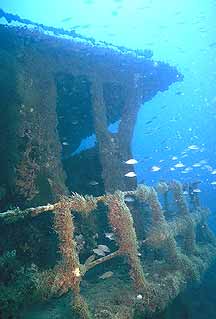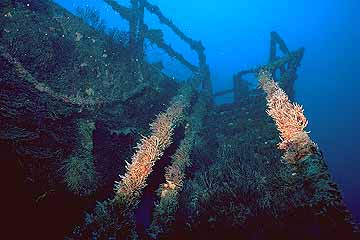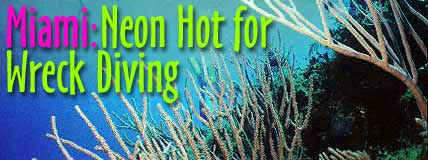|
f l o r i d a
|
Artificial
Reef Map with Links to Dive Shops (with FLASH 4 ) (Non Flash) Coral Reefs Diving 101 Florida Marinas Florida Boating |
||
Photos by H2O Scuba Miami Beach's historic Art Deco district is neon-hot, thanks to trendy Ocean Drive, busy Lincoln Road, unique accommodations options, and some of the most creative restaurants in the U.S. But scuba diving off Miami Beach is just as hot, thanks to one of the best artificial reef programs in the world. Miami Beach has been dubbed "The Wreckreational Capital of the Americas" and rightly so, as divers from North and South America are converging on an area that is second only to Truk Lagoon in sheer numbers of wrecks. In many ways, Miami was a natural to become an unnatural artificial reef mecca. Shipwrecks and other manmade items may not seem natural 'reefs' at first, but it  doesn't
take them long to fit in quite well. Miami's weather and diving conditions
make them natural fits for divers. doesn't
take them long to fit in quite well. Miami's weather and diving conditions
make them natural fits for divers.In 1981, when Dade County initiated the Artificial Reef Program, there was just one dive boat operating in the Greater Miami area. Today, the program is recognized as one of the most successful artificial reef programs in the nation. The number of dive boats has increased to more than a dozen, providing everything from shallow water snorkeling on natural reefs to diving on boats, tanks, towers, and much more. The 'founding father' of Miami diving is definitely Ben Mostkoff. As former coordinator of the active program, he was responsible for obtaining and coordinating the sinking of most of the wrecks. Without Ben, Miami probably wouldn't be the wreckreational dive mecca it has become. There are ten designated offshore artificial reef sites, with five lying between the Dade/Broward county line and Key Biscayne and another five situated between Key Biscayne and Monroe County. Most of the best diving is in less than 130 feet of water and less than two miles east of Sunny Isles, Miami Beach, and the Key Biscayne shoreline. The sites contain more than 30 ships, two Tenneco oil platforms, a pair of U.S. Army tanks, more than 650 concrete and limestone structures, and many other interesting artificial reefs. It's enough to keep every level of diver interested for many Miami visits. A NEON-HOT TRIO OF WRECKS The Orion provides a perfect introduction to the vice of Miami artificial reef diving. Sunk in 1981 off Key Biscayne in the south, it was the first ship sunk by the Dade County  Environmental
Resources Management Artificial Reef Program and is still one of the best
and most popular dives. Environmental
Resources Management Artificial Reef Program and is still one of the best
and most popular dives.The 120-foot ship was originally named the Trinidad and guided ships through the Panama Canal for almost 50 years before being sunk off Key Biscayne. As with most Miami wrecks, the ship has been stripped for safe diving and can be entered (a light helps, even during daytime diving). Located in 95 feet of water and with a profile of 30 feet, it's a mature wreck with lots of colorful marine life and coral growth. The colors challenge those found on neon-laden Ocean Drive. CLICK FOR MORE |
|||

